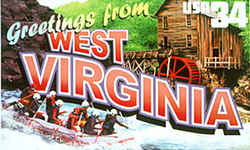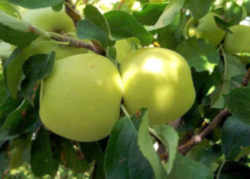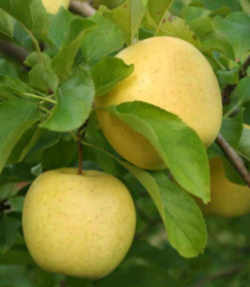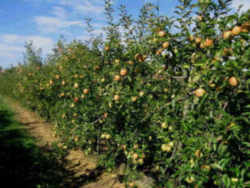
West Virginia Symbols
West Virginia State Fruit
Golden Delicious Apple

(Malus pumila)
Adopted on March 7, 1972; February 20, 1995
The Golden Delicious apple, (Malus pumila,) was designated as the official State Fruit by Senate Concurrent Resolution No. 7, adopted by the Legislature on February 20, 1995. This apple variety was discovered by Anderson Mullins in Clay County, West Virginia, in 1905. The plain apple had been previously designated as the official State Fruit by House Concurrent Resolution No. 56, adopted March 7, 1972.
West Virginia State Fruit: Golden Delicious Apple

Apples are members of the rose family, or Rosaceae, and the genus Malus. The common wild apple of Europe and Asia is Malus pumila. Other wild species are Malus sylvestris (a wild crab apple), and Malus baccata. Cultivated apples are also called Malus pumila, though they may also be descended from one or more of the other wild species.
The alternate, simple, toothed leaves of Apple are variable in size and shape. Mature Apple trees often have extensive development of spur branches, although they are frequently lacking on and fast growing young branches at the outer edge of the canopy, and on young plants. The dense, almost wooly hairs on the buds can be a helpful character to confirm the identity of Apple. Bark of mature trunks tends to have a smooth inner layer with a subtle reddish hue, and peeling sections of an outer grayish layer. Bark of young branches is often smooth and much different in appearance then the bark of mature trunks. The growth form of Apple trees (even escapes) grown in full sun is distinctive and familiar to many people. The trunk divides low into several major branches and the canopy is typically as wide or wider than tall. Escapes developing under (with) forest canopy are usually taller and less spreading of form and may require closer examination.
The Greatest Apple in the World
 "Eureka! I found
it!" Those were the words of Paul Stark of Stark Brothers Nursery when he bit into a new and exciting apple in 1914.
"Eureka! I found
it!" Those were the words of Paul Stark of Stark Brothers Nursery when he bit into a new and exciting apple in 1914.
He found that special apple on a thousand-mile treasure hunt which started in the town of Louisiana, Missouri, the home of Stark Brothers, and ended
on a hillside in Clay County, West Virginia. The apple, later to be called the Golden Delicious, has become our state's most famous contribution to
horticulture.
Truly there was gold found in the hills of West Virginia on that special day. The offspring of the original Golden Delicious tree have dropped wealth
in every area of the United States and on every continent of the world. Over the years the Golden Delicious has become a standard in commercial and
backyard orchards. There is a piece of West Virginia in all parts of the world, due to the popularity of this apple found as a chance seedling on a
small farm in Clay County.
No one, at the time the Golden Delicious was discovered, had ever set eyes on such an apple. Red apples dominated at the turn of the century. The new
tree soon changed that. It bore huge yellow apples. And yes, they were delicious. "With one in your hand, you can't be sure whether you're drinking
champagne or eating an apple," Stark enthused.
Others were similarly impressed. Dr. John Harvey Kellogg, founder of the Kellogg's breakfast food company, wrote in a letter to Stark Nurseries, "I
consider the Golden Delicious the finest apple I have ever tasted." Kellogg, an ardent health food proponent, was preparing to plant an orchard on
his property.
Luther Burbank concurred. "After observing the Golden Delicious in my experiment grounds and giving it careful tests, I have no hesitancy in stating
that it is the greatest apple in all the world," the legendary plant breeder reported.
Paul Stark set out to find the tree in the fall of 1914, the next bearing season after he first tasted a sample of the fruit. What he later called
the "trail of the Golden Delicious Apple" ended at the small hamlet of Odessa, several miles south of the Elk River, near the Clay - Kanawha line.
Bewel Mullins had previously owned the Odessa farm, 36 acres located on a hill by Porter Creek. Mullins and his wife Nancy and three children lived
there. "My father was a farmer and cattle driver in the area. He would herd cattle to market and to other farms," remembered Roberta Mullins McQuain,
Bewel's daughter who now lives in Charleston.
Bewel is the West Virginian who came to be most closely associated with the Golden Delicious tree, but he didn't occupy the farm at the time of the
grand discovery. Anderson Mullins, (Bewel's brother) became the tenant of the former Bewel Mullins farm and he was a true apple lover. For several
years Anderson had bought his apple stock from Stark Brothers Nursery. At that time, Stark was the major commercial mail-order company for fruit trees,
known throughout the country by its advertising.
Anderson Mullins was alive and active in the early years of the 20th century. It was the fall of 1905 when he first noticed a bumper crop of yellow
apples burdening a tree he knew hadn't been planted in the home orchard and which must have grown from seed. For the next nine years he marveled at
the mysterious tree's ability to produce when other trees didn't. Also remarkable was the apple's ability to keep fresh and crisp in storage until
late spring.
Anderson Mullins knew he had something special. Figuring that his favorite nursery might be interested, he proceeded to send Stark Brothers samples
of the fruit of his "Mullins Yellow Seedling." "Anderson sent us three apples and a modest letter explaining its characteristics," according to Paul
Stark, Jr.
Because of the Starks' love of red apples and the fact that yellow apples had never been best sellers, Paul Stark, Sr., wasn't especially optimistic
when the West Virginia fruit arrived in Missouri. But when the Clay County apples were sliced Paul and his brother Lloyd couldn't believe their taste
buds. "We had never experienced such a spicy flavor before, especially from a yellow apple," Paul Stark afterwards reported.
So Anderson Mullins definitely got the attention of Stark Brothers Nursery with his three apples. In a 1964 article titled "The Golden Apple" Paul
Stark, Jr., wrote of what happened next: "There was only one way to get from Louisiana, Missouri, to West Virginia and that was by railroad and horse
and Buggy. For a thousand miles, Paul Stark, Sr., traveled by rail. The final 25 miles was on horseback to a point on Porter's Creek called Odessa."
"When he arrived at the Anderson Mullins farm, he knocked on the cabin door, but nobody answered. He then decided to look around, going up on the hill
behind the cabin where a small orchard was planted."
Let's pick up the story now in the words of Paul, Sr., as quoted in a company catalog: "There, looming forth in the midst of small leafless barren
trees, was one tree with rich green foliage as if it had been transplanted from the Garden of Eden. That tree's boughs were bending to the ground beneath
a tremendous crop of great, glorious, glowing golden apples."
"I started for it on the run, a fear bothered me. Suppose it's just a Grimes Golden apple after all. I came closer and saw the apples were 50 percent
larger than Grimes Golden. I picked one and bit into its crisp, tender, juice-laden flesh. Eureka! I had found it!"
A mountain farmer appeared just as the Missourian was enjoying his apple. Stark identified himself, saying, "That's some apple."
"Name's Mullins," the man said, "I sent you some."
After meeting in the orchard, Paul Stark and Anderson Mullins sat down to make their business arrangements. Taking no chances, Stark ordered the tree
enclosed before he returned to Missouri.
"Several accounts exist as to what Anderson Mullins got for his special tree," retired Clay County Extension Agent Paul Allen recently told me. "The
general consensus was that he was paid at least $5,000." Some members of the Mullins family recall that the tree was actually rented for $5,000 and
then purchased for an additional $5,000.
When Stark left the Mullins farm that historic day in 1914, he took with him a bundle of scion wood to graft to his apple trees back in Missouri. It
was only two years after the grafts were complete and had produced a crop of yellow apples that he gave his new apple the name "Golden Delicious."
No doubt he hoped to capitalize on the comparison to the popular Red Delicious, another Stark apple.
Shortly after Anderson sold the rights to the Golden Delicious apple to Stark Brothers Nursery, Bewel and Anderson Mullins agreed to swap farms. It
was Bewel who was paid by Stark Brothers to maintain the original Golden Delicious for the next 30 years.
For protection against thieves, Stark had had a 30 by 30-foot cage constructed out of wood and woven wire that completely engulfed the tree. "Dad had
an electric alarm on the cage to detect intruders," Mrs. McQuain recalled. "The alarm wires stretched from the tree's cage behind the house to an alarm
in the kitchen."
The 900-square-foot area was bought by Stark Brothers, and the deed still rests in the Clay County Courthouse. Paul Allen figures it was "the most
valuable piece of real estate of its size in West Virginia."
The mother tree produced quality apples for nearly 50 years. The seedling had sprouted around the turn of the century, and apparently the old tree
had borne its last apple and died by the late 1950's.
Paul Allen corroborates that approximate date. He remembers November 6, 1958, when he and WVU professors Joseph Barrat and David Quinn scaled the hillside
behind the old Mullins home. They were in search of any remains of the famous Golden Delicious tree. "Hopefully we could find living shoots so that
we could propagate directly from the original tree," Paul recently recalled.
"We went through a dilapidated gate supporting a rusty fence. The original tree was there but it showed no signs of life," Paul continued. David Quinn
took a few pictures of the dead tree and later sketched its final image in a pen-and-ink drawing.
Nowadays the only evidence that the tree of gold grew up the hill from Porter Creek is an historical marker located on Route 1 nearby. But the old
tree did its job in bringing one of the great, good things into the world. And even though the original stands no more, one only has to visit the nearest
supermarket to get a delicious reminder of the famous apple born in Clay County.
Each fall, Clay County celebrates its famous apple with the annual Clay County Golden Delicious Festival. The first festival, in 1973, featured country-and-western
star Tex Ritter as the grand marshal. That first year the "world's largest apple pie" was baked, measuring a whopping six feet across and filled with
spicy, juicy Golden Delicious apples.
The above is a condensation of an article entitled "The Greatest Apple in the World": Striking Gold in the Clay County Hills,
that appeared in the Fall 1995 issue of Gold Seal magazine published by the Division of Culture and History of the State of West Virginia. The article
was written by John L. Marra.
West Virginia CONCURRENT RESOLUTION NO. 7
As a concurrent resolution, it was required that Senate Concurrent Resolution No. 7 be approved in both houses of the West Virginia Legislature. Senate Concurrent Resolution No. 7 was approved in the Senate on February 16, 1995 and in the House of Delegates on February 20, 1995.
West Virginia SENATE CONCURRENT RESOLUTION NO. 7
(By Senators Jackson, Love, Schoonover, Helmick, Blatnik and Sharpe)
Designating the golden delicious apple as the official state fruit.
Whereas, The golden delicious apple was discovered by Anderson Mullins in Clay County in 1905; and
Whereas, By 1921, the golden delicious apple became the leading variety of apple tree in the United States and abroad; and
Whereas, Close to two hundred billion pounds of golden delicious apples are grown annually in the United States; and
Whereas, The golden delicious apple has been planted in every continent in the world; and
Whereas, The golden delicious apple is an apple variety native to West Virginia and the plain apple is presently designated as the state fruit; therefore,
be it
Resolved by the Legislature of West Virginia:
That the golden delicious apple is hereby designated as the official state fruit; and, be it
Further Resolved, That the Clerk of the Senate is hereby requested to forward a copy of this resolution to Guyan Valley Junior High School.
West Virginia Law
Because the golden delicious apple was designated by Senate Concurrent Resolution, it is not listed in the West Virginia Code.
Taxonomic Hierarchy: Golden Delicious Apple
Kingdom: Plantae - Plants
Subkingdom: Tracheobionta - Vascular plants
Superdivision: Spermatophyta - Seed plants
Division: Magnoliophyta - Flowering plants
Class: Magnoliopsida - Dicotyledons
Subclass: Rosidae
Order: Rosales
Family: Rosaceae - Rose family
Genus: Malus Mill. - apple
Species: Malus pumila P. Mill. - paradise apple

List Official US State Foods






